This Hummingbird Is Just So Weird! Can You Guess Why?
Welcome to another post of my strange animals series where you get to meet some of the weirdest, coolest, and craziest animals in the world.
Today I want to talk about a weird hummingbird I first heard of from @jaki01's latest video . This hummingbird really blew my mind. Why? Well, let's first see his video:
As you can see, this hummingbird looks and flies like any other hummingbird! So, what's so weird about it?
Well... For starters it's not a hummingbird! It's not even a bird! It's a freaking bug!
Here, have a closer look:
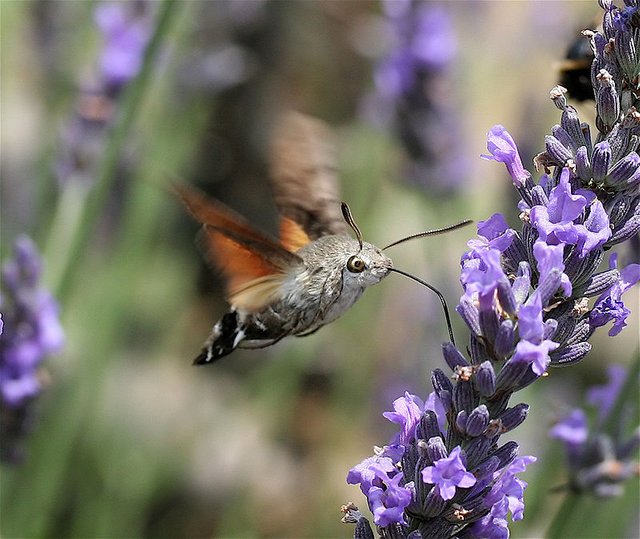
Hummingbird Hawk-Moth (credit)
Scientifically described as Macroglossum stellatarum and commonly known as the hummingbird hawk-moth this creature is named after its remarkable resemblance to...hummingbirds.
From afar, the inexperienced eye would easily be fooled by the looks and hovering behavior of this creature. It even sounds like a hummingbird, as it produces a similar "humming" noise! Only on closer inspection will one notice that this "hummingbird" looks a bit a different!
Now, let's learn more about this weird critter!
Where Can I Find One?
The species occurs year-round in the temperate regions of Europe and Asia but its total range reaches up to Northern Africa in the winter and during the summer, individuals can be spotted northward into Europe and Russia [1]
This is a really strong flier, capable of travelling great distances and there have even been sightings in Newfoundland, Canada and Malaysia [2]
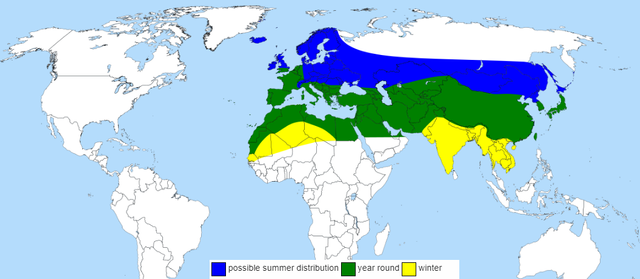 Distribution map of M. stellatarum (credit)
Distribution map of M. stellatarum (credit)
If you are really on the look out for one, the best time is during the day as this a diurnal (active during the day) animal, especially in bright sunshine. However, individuals are also somewhat active at dusk, dawn, and even in the rain.
Fun Fact: Since there are no hummingbirds endemic to Europe, many if not all of numerous sightings of hummingbirds in Europe actually from people mistaking these moths for hummingbirds.
Why Does It Look Like A Hummingbird?
The resemblance of M. stellatarum to hummingbirds is an excellent example of convergent evolution. Here's a definition in case this is the first time you hear the term:
"Convergent evolution is the independent evolution of similar features in species of different lineages. Convergent evolution creates analogous structures that have similar form or function but were not present in the last common ancestor of those groups." [5]
In simple words, convergent evolution "happens" when distantly-related organisms develop similar characteristics to address similar challenges. A simple example are dolphins and sharks which both converged on many traits for fast swimming. On the outside they look quite similar, but one is a fish and the other a mammal:
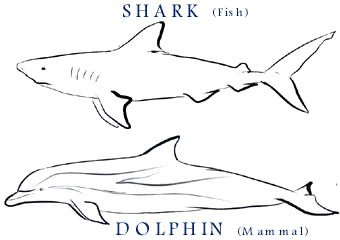
(credit)
As for M. stellatarum, the two main converged traits are:
- The long proboscis (instead of a long beak) that helps it sip nectar from flowers
- The strong wings which allow it to hover around flowers while sipping nectar.
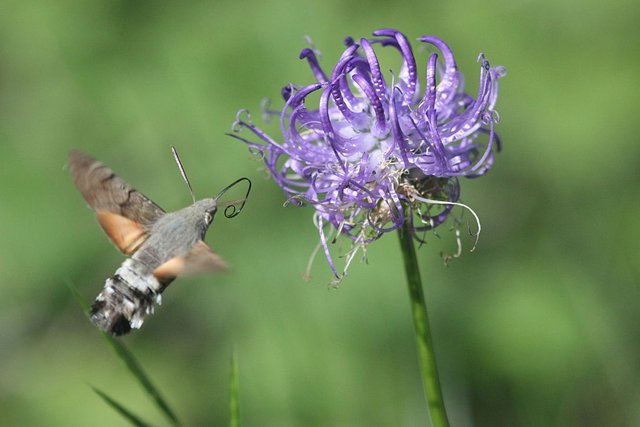 (credit)
(credit)
What Does It Eat?
Adult are known to sip on the nectar of all kinds of flowers occurring in parks, gardens and forests. Some examples of these plants include Centranthus, Jasminum, Nicotiana, Buddleia, Viola, Verbena, Stachys, Primula, Syringa, and Phlox. [4]
As for caterpillars, they are known to "feed on bedstraws or madders (Rubia) but have been recorded on other Rubiaceae and Centranthus, Stellaria, and Epilobium." [2]
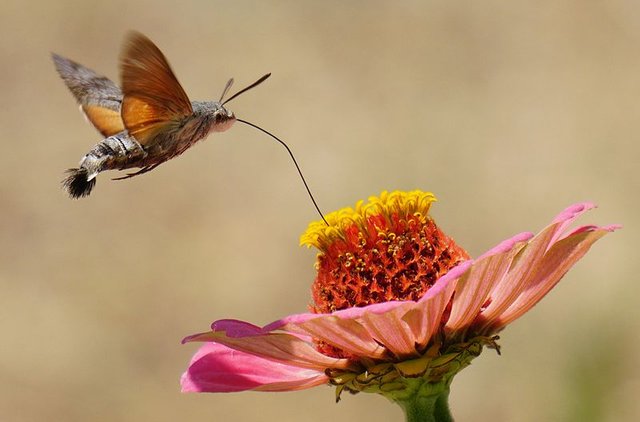
Life-cycle & Morphology
Like all lepidoptera (butterflies & moths), the hummingbird hawk-moth has a pretty straightforward lifecycle. It starts as an egg which hatches into a larva that eventually transforms into a moth. Nothing really worth-mentioning occurs during its lifecycle:
Eggs: The glossy pale green eggs are spherical with a 1-millimetre (0.039 in) diameter. They are said to look like the flower buds of the host plant Galium, and that is where the female lays them. They hatch 6 to 8 days after laying. Up to 200 eggs may be laid by one female, each on a separate plant.
Larvae: Newly hatched larvae are clear yellow, and in the second instar assume their green coloration. The larva is green with two grey stripes bordered in cream along the sides and the horn at the rear end typical of sphingids. They feed fully exposed on the top of the host plant and rest in among a tangle of stems. Although dependent on warmth and sun, the larval stage can be as rapid as 20 days.
Pupae: The pupae are pale brownish with a prominent, keeled proboscis, and two sharp spines at the end of the cremaster. T
Adults: The forewings are brown, with black wavy lines across them, and the hindwings are orange with a black edge. The abdomen is quite broad, with a fan-tail of setae at the end. The wingspan is 40–45 millimetres (1.6–1.8 in). [2]
As mentioned before, this moth is a really strong flier. Although its' top speed has yet to be measured, it's believed to be something around around 12 miles per hour, which is the speed of the closely related Manduca sexta, which has more or less the same speed. [1]
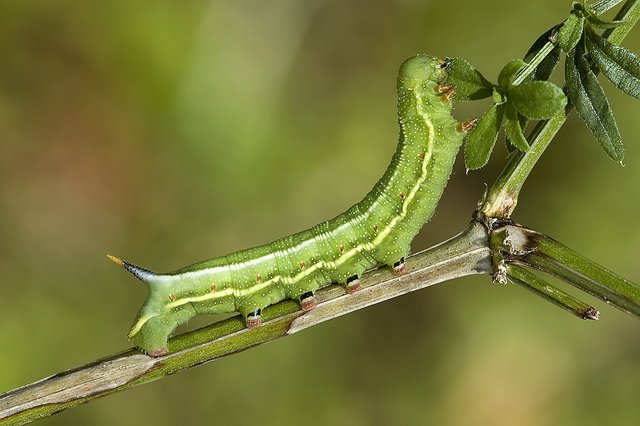 Macroglossum stellatarum caterpillar (credit)
Macroglossum stellatarum caterpillar (credit)
Is The Species Threatened?
The conservation status of the species has yet to be assessed by the IUCN, however it doesn't appear to be under any immediate threat, considering its' wide range distribution and the fact that sightings are very common.
Can I Eat One?
Although Sphingidae larvae are slightly toxic, I couldn't find anything about M. stellatarum adults being toxic or poisonous. My guess is that yeah you can eat one. Good luck catching one, they are really fast!
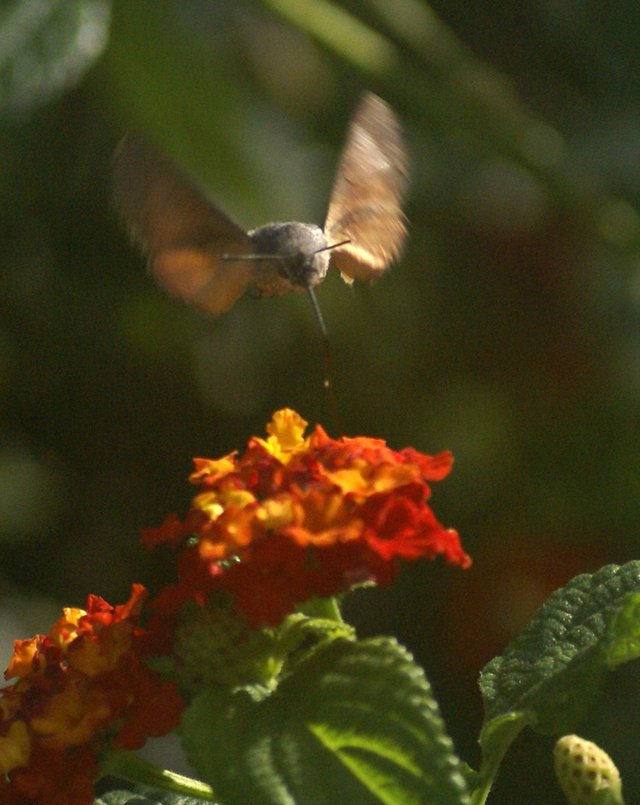 (credit)
(credit)
The End
So, that's pretty much all the basics you need to know about today's strange animal! I really hope it surprised you as much as it did me! Below I have included some videos if you want to see it in action. Don't forget to check the references if you want to learn more about it!
Videos
More Strange Animals
Here are some of my latest posts. If you like reading about strange animals I think you will like them:
- This Deep Sea Creature Looks Like An Alien Spaceship (Lampocteis cruentiventer)
- 3 Very Strange Animals I First Heard Of This Week
- The Weird Looking Cantor's Giant Softshell Turtle
- Gasteracantha: Tiny Spiders From Hell!
- 7 Horrifying Micro-Monsters That Will Haunt Your Dreams
- Greta oto: The Butterfly With The Transparent Wings
- Crickets, Grasshoppers And Other Disgusting Things Are An Excellent Source Of Iron (And Other Minerals!)
References
- Pbs.org/wnet/nature/blog/featured-creature-hummingbird-hawk-moth/
- Wikipedia.org/wiki/Hummingbird_hawk-moth
- Eol.org/pages/396579/details
- Animalspot.net/hummingbird-hawk-moth.html
- Wikipedia.org/wiki/Convergent_evolution
 Steemstem & SteemitEducation
Steemstem & SteemitEducation
Steemstem is the go-to place for science on Steemit. Check it out at @steemstem or visit the #steemSTEM channel. A big thank you also goes to the guys from @steemiteducation for supporting my content!
Greek Community
A final big thanks goes to my fellow greeks for their support and love. Follow the greek-trail or check the facebook page for more greek content!

We have a similar species in the USA. I was hoping this was a contest because I knew right away it was a moth. We used to have them in our garden in Texas!
From MAP, great job!!!!
The enormous nature! An amazing lesson!
I like most the part of your posts when you ask 'can I eat one?'. Hahaha. Very good read again @trumpman. Thanks :D
yeah, I think it's a funny way to talk about toxicity and stuff :D
I totally agree. It's funny and very engaging to read. :D
Συγχαρητήρια @trumpan για τα πολύ ενδιαφέροντα ποστ σου!!!¨)
ευχαριστώ!
Hmm nice write up, I think I have seen this specie before on one of my travels, I distinctly remember it's somewhat furry surface.
img credz: pixabay.com
Nice, you got a 6.0% @minnowbooster upgoat, thanks to @trumpman
Want a boost? Minnowbooster's got your back!
The @OriginalWorks bot has determined this post by @trumpman to be original material and upvoted it!
To call @OriginalWorks, simply reply to any post with @originalworks or !originalworks in your message!
For more information, Click Here!
Special thanks to @reggaemuffin for being a supporter! Vote him as a witness to help make Steemit a better place!
As a follower of @followforupvotes this post has been randomly selected and upvoted! Enjoy your upvote and have a great day!
This post has received a 1.19 % upvote from @buildawhale thanks to: @trumpman. Send at least 0.50 SBD to @buildawhale with a post link in the memo field for a portion of the next vote.
To support our daily curation initiative, please vote on my owner, @themarkymark, as a Steem Witness
https://steemit.com/steemstem/@light-o-trix/defense-strategy-and-capabilities-development-across-the-globe-is-it-a-threat-for-the-human-race
here's a flag for you. Next time, don't spam
Sorry I was unaware of the spamming process, I am new and just learning. From next time onward I will utilize your valuable guidance. Thanks for informing me!!